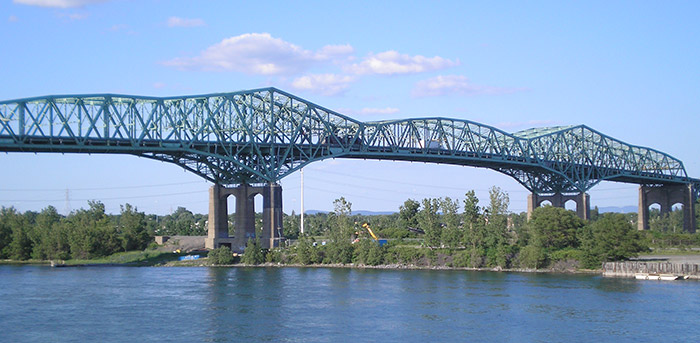CHAMPLAIN BRIDGE, MONTREAL
She drove through the Ville-Marie Tunnel, then up onto the Champlain Bridge. Gamache was silent, looking at the half-frozen St. Lawrence River far below. The traffic slowed almost to a stop once they approached the very top of the span. Lacoste, who was not at all afraid of heights, felt queasy. It was one thing to drive over the bridge, another to be stopped within feet of the low rail. And the long plunge. (How the Light Gets In, Page 22, Hardcover Edition)
Hovering high above the St. Lawrence River and nearly four miles long, the Champlain Bridge connects Three Pines with Montreal and features heavily into the works of Louise Penny.

Named after Samuel de Champlain (remember his remains play a big role in Bury Your Dead), the intrepid explorer who founded Quebec City and New France. The bridge is a steel truss cantilever and was designed by Philip Louis Pratley. Pratley also had a hand in building the Quebec Bridge which also crosses the St. Lawrence and is the largest cantilever in the world.
Begun in 1957, construction took five years to complete and the Champlain now hosts six lanes of traffic and has nearly 50 million vehicles cross its span per year, making it Canada’s busiest bridge.
If you recall, our own Chief Inspector Gamache is afraid of heights and at 120 feet above the river, at its highest point, the bridge unnerves Armand; “…his hands were balled into fists, which he was tightening, then releasing. Tightening. Releasing.”
How the Light Gets In begins with a body being discovered and “brought up from the side of the Champlain Bridge” and sadly, like many bridges, the Champlain has seen its fair share of deaths but not nearly as many as its sister bridge, the Jacques Cartier, which has had as many as 16 suicides in a single year.

The overall state of the Champlain plays a big part in the plot of the novel and this, like many of Louise’s themes, is more fact than fiction. The bridge has suffered heavy deterioration over the years and a 2010 study revealed that the bridge is “functionally deficient” thus a strategy was put in motion to replace it.
In 2014 the new plan for the replacement bridge was unveiled with completion scheduled for 2018. It will maintain its six lanes of traffic and add in a separate span for bicycle and pedestrian paths.
While many are referring to the new structure simply as the “New Champlain Bridge”, it has not been officially named.
What do you say we all lobby for it to be christened the “Louise Penny Bridge”?


